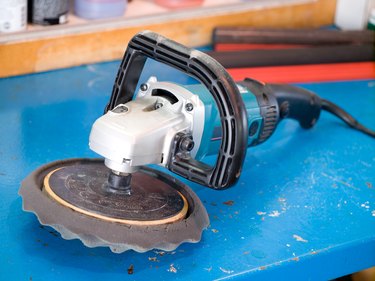Things You’ll Need
-
Work apron
-
Protective goggles
-
Rubbing compound
-
Clean buffer bonnets
-
Clean rags
-
Paste wax
-
Steel wool
 Use a buffer in an area where flying debris won’t cause damage. Image Credit: Jupiterimages/Photos.com/Getty Images
Use a buffer in an area where flying debris won’t cause damage. Image Credit: Jupiterimages/Photos.com/Getty Images
Buffing out the final finish on a piece of wood furniture is tantamount to achieving a smooth, professional-looking job. The work is painstaking and time-consuming, but an electric buffer reduces the time significantly. In fact, it takes at least 10 to 20 passes by hand to achieve the same results that one pass of an electric buffer provides. And, the even, high-powered rotations of the electric buffer increase your odds of achieving a glossy finish that looks and feels like glass.
Video of the Day
Step 1
Allow the final coat of varnish or polyurethane to dry thoroughly before beginning the buffing process. The longer you allow it to set, the better final finish you'll get, according to Homestead Finishing Products. Let water-based lacquers and shellac cure for a week. Wait two weeks before buffing out polyurethane and oil-based varnishes, or if the furniture has three or more coats of finish.
Step 2
Place the piece of furniture in an area where flying debris and dust won't cause damage. Wear a work apron and clear protective goggles.
Step 3
Squeeze several lines of liquid rubbing compound on the wood, or apply a paste compound with a sponge.
Step 4
Put a clean bonnet on the buffer. Turn the buffer on low.
Step 5
Place the buffer lightly on the surface of the wood, tilting it about 2 or 3 degrees. Move the buffer slowly and evening, from side to side — do not stop to buff just one spot — until most of the compound disappears.
Step 6
Wipe off any compound dust the buffer couldn't reach with a clean rag.
Step 7
Change the buffer bonnet and apply wax to the wood surfaces again. Repeat the buffing process until the wax is buffed clear.
Tip
How you take care of your furniture affects how often you'll have to refinish it. For example, furniture left in humid areas may cause the finish to crack after two or three years. Furniture polish can build up and make the finish look streaked and gummy. Use a damp cloth or oil soap to keep it clean and maintain the finish for 10 years or more before it needs buffing.
Warning
Use fine sandpaper or steel wool to rub out rounded edges and grooves that the electric buffer can't reach. Finishes tend to collect a little heavier in those areas. If you hold the buffer in one spot too long, you risk gouging the wood.



























